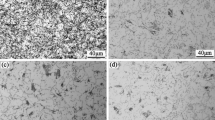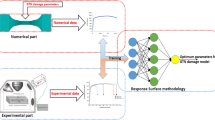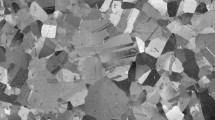Abstract
The mechanical properties and microstructural evolution of high-strength bainitic steel before and after hydrogen charging were investigated by nanoindentation creep tests and multiscale morphology observations. The results showed that hydrogen charging led to higher local nanoindentation hardness and lower stress exponent of the steel. The elongation of the material decreased, and the susceptibility to hydrogen embrittlement increased after charging. SEM observation showed that the presence of hydrogen changes the material’s fracture characteristics from ductile to a mixture of ductile and transgranular cleavage fracture. TEM and SADP analysis indicated that the energetically favorable and stress-promoted hydrogen induced the enhanced dislocation activity in the lath, and the hydrogen might accumulate at the interface between the harder M-A and the softer substrate, as well as at GB. The influence of hydrogen on material properties is caused by the interaction of hydrogen-induced local hardening and hydrogen-induced cracking.


















Similar content being viewed by others
Data Availability
All data generated or analyzed during this study are included in this article.
References
Z.Y. Liu, X.Z. Wang, C.W. Du, J.K. Li and X.G. Li, Effect of Hydrogen-Induced Plasticity on the Stress Corrosion Cracking of X70 Pipeline Steel in Simulated Soil Environments, Mater. Sci. Eng. A, 2016, 658, p 348–354.
F.L. Ma, J.L. Li, Z.X. Zeng and Y.M. Gao, Tribocorrosion Behavior in Artificial Seawater and Anti-microbiologically Influenced Corrosion Properties of TiSiN-Cu Coating on F690 Steel, J Mater. Sci. Tech., 2019, 35(03), p 448–459.
I.J. Park, K.H. Jeong, J.G. Jung, S.L. Chong and Y.K. Lee, Mechanism of Enhanced Resistance to the Hydrogen Delayed Fracture in Al-added Fe-18Mn-0.6C Twinning-Induced Plasticity Steels, Int. J Hydrogen Energy, 2012, 37, p 9925–9932.
S. Feliu and M. Morcillo, The Prediction of Atmospheric Corrosion from Meteorological and Pollution Parameters, Corros. Sci, 2013, 34(3), p 403–414.
H.C. Ma, C.W. Du, Z.Y. Liu and X.G. Li, Effect of SO2 Content on SCC Behavior of E690 High-Strength Steel in SO2-Polluted Marine Atmosphere, Ocean Eng., 2018, 164, p 256–262.
H.Y. Tian, X. Wang, Z.Y. Cui, Q.K. Lu, L.W. Wang, L. Lei, Y. Li and D.W. Zhang, Electrochemical Corrosion, Hydrogen Permeation and Stress Corrosion Cracking Behavior of E690 Steel in Thiosulfate-Containing Artificial Seawater, Corro. Sci., 2018, 144, p 145–162.
T.L. Zhao, Z.Y. Liu, C.W. Du, M.H. Sun and X.G. Li, Effects of Cathodic Polarization on Corrosion Fatigue Life of E690 Steel in Simulated Seawater, Int. J Fatigue, 2018, 110, p 105–114.
H.C. Ma, L.H. Chen, J.B. Zhao, Y.H. Huang and X.G. Li, Effect of Prior Austenite Grain Boundaries on Corrosion Fatigue Behaviors of E690 High Strength Low Alloy Steel in Simulated Marine Atmosphere, Mater. Sci. Eng. A, 2020, 773, p 138884.
C. Pandey, N. Saini, M.M. Mahapatra and P. Kumar, Hydrogen Induced Cold Cracking of Creep Resistant Ferritic P91 Steel for Different Diffusible Hydrogen Levels in Deposited Metal, Int. J. Hydrogen Energ., 2016, 41(39), p 17695–17712.
C. Pandey, M.M. Mahapatra, P. Kumar, N. Saini and A. Srivastava, Microstructure and Mechanical Property Relationship for Different Heat Treatment and Hydrogen Level in Multi-Pass Welded P91 Steel Joint, J. Manuf. Process, 2017, 28, p 220–234.
A. Barnoush and H. Vehoff, In situ Electrochemical Nanoindentation: A Technique for Local Examination of Hydrogen Embrittlement, Corros. Sci., 2008, 50, p 259–267.
L.W. Wang, J.M. Liang, H. Li, L.J. Cheng and Z.Y. Cui, Quantitative Study of the Corrosion Evolution and Stress Corrosion Cracking of High Strength Aluminum Alloys in Solution and Thin Electrolyte Layer Containing Cl-, Corros. Sci, 2021, 178, p 109076.
L. Zhang, B. An, S. Fukuyama and K. Yokogawa, Hydrogen Effects on Localized Plasticity in SUS310S Stainless Steel Investigated by Nanoindentation and Atomic Force Microscopy, Jpn. J Appl. Phys., 2009, 48, p 8.
Y. Shi, L. Collins, R. Feng, C. Zhang, N. Balke, P.K. Liaw and B. Yang, Homogenization of AlxCoCrFeNi High-entropy Alloys with Improved Corrosion Resistance, Corros. Sci., 2018, 133, p 120–131.
G. Yang, Y. Zhao, D.H. Lee, J.M. Park, M.Y. Seok, J.Y. Suh, U. Ramamurty and J.I. Jang, Influence of Hydrogen on Incipient Plasticity in CoCrFeMnNi High-entropy Alloy, Scr. Mater, 2019, 161, p 23–27.
D.S. Liu, B.G. Cheng and Y.Y. Chen, Fine Microstructure and Toughness of Low Carbon Copper Containing Ultra-High Strength NV-F690 Heavy Steel Plate, Acta Metall. Sin., 2012, 48(3), p 334–342.
M.A. Arafin and J.A. Szpunar, Effect of Bainitic Microstructure on the Susceptibility of Pipeline Steels to Hydrogen Induced Cracking, Mater. Sci. Eng. A, 2011, 528, p 4927–4940.
W.D. Nix and H.J. Gao, Indentation Size Effects in Crystalline Materials: A Law for Strain Gradient Plasticity, J Mech Phys Solid, 1998, 46, p 411–425.
Y.J. Hong, C.S. Zhou, Y.Y. Zheng, L. Zhang, J.Y. Zheng, B. An, X.Y. Chen and X.H. Wang, Hydrogen Effect on the Deformation Evolution Process In situ Detected by Nanoindentation Continuous Stiffness Measurement, Mater. Charact., 2017, 127, p 35–40.
K.A. Nibur, D.F. Bahr and B.P. Somerday, Hydrogen Effects on Dislocation Activity in Austenitic Stainless Steel, Acta Mater, 2006, 54, p 2677–2684.
A. Barnoush, M. Asgari and R. Johnsen, Resolving the Hydrogen Effect on Dislocation Nucleation and Mobility by Electrochemical Nanoindentation, Scripta Mater, 2012, 66, p 414–417.
J. Hou, X.S. Kong, C.S. Liu and J. Song, Hydrogen Clustering in Bcc Metals: Atomic Origin and Strong Stress Anisotropy, Acta Mater, 2020, 201, p 23–35.
Z. Cao and X. Zhang, Nanoindentation Creep of Plasmaenhanced CVDed Silicon Oxide Films, Scripta Mater., 2007, 56, p 249–252.
D.H. Lee, J.A. Lee, M.Y. Seok, U.B. Baek, S.H. Nahm and J.I. Jang, Stress Dependent Hardening-to-softening Transition of Hydrogen Effects in Nanoinde Ntation of a Linepipe Steel, Int. J Hydrog. Energy, 2014, 39, p 1897–1902.
F. Wang and K. Xu, An Investigation of Nanoindentation Creep in Polycrystalline Cu Thin Film, Mater. Lett., 2004, 58, p 2345–2349.
Z.L. Xu, H. Zhang, W.H. Li, A.Q. Mao, L. Wang, G.S. Song and Y.Z. He, Microstructure and Nanoindentation Creep Behavior of CoCrFeMnNi Highentropy Alloy Fabricated by Selective Laser Melting, Addit. Manuf., 2019, 28, p 766–771.
X. Gao, Displacement Burst and Hydrogen Effect During Loading and Holding in Nanoindentation of an Iron Single Crystal, Scripta Mater, 2005, 53, p 1315–1320.
Y.J. Hong, C.S. Zhou, Y.Y. Zheng, J.Y. Zheng, L. Zhang and X.Y. Chen, Hydrogen Effect on Nanoindentation Creep of Austenitic Stainless Steel: A Comparative Study Between Primary Creep Stage and Steady-State Creep Stage, Int. J Hydrog. Energy, 2019, 44(40), p 22576–22583.
T. Depover, T. Hajilou, D. Wan, D. Wang, A. Barnoush and K. Verbeken, Assessment of the Potential of Hydrogen Plasma Charging as Compared to Conventional Electrochemical Hydrogen Charging on Dual Phase Steel, Mater. Sci. Eng A, 2019, 754, p 613–621.
T. Michler, M.C. San, J. Naumann, S. Weber and M. Martin, Hydrogen Environment Embrittlement of Stable Austenitic Steels, Int. J. Hydrog. Energy, 2012, 37, p 16231–16246.
X.C. Ren, Q.J. Zhou, G.B. Shan, W.Y. Chu, J.X. Li, Y.J. Su and L.J. Qiao, A Nucleation Mechanism of Hydrogen Blister in Metals and Alloys, Metall Mater Trans A, 2008, 39A, p 87–97.
X.F. Li, W.H. Huang, X.B. Wu, J. Zhang, Y. Wang, E. Akiyama and D.W. Hou, Effect of Hydrogen Charging Time on Hydrogen Blister and Hydrogen-Induced Cracking of Pure Iron, Corros. Sci., 2021, 181, p 109200.
M.Q. Wang, E. Akiyama and K. Tsuzaki, Effect of Hydrogen on the Fracture Behavior of High Strength Steel During Slow Strain Rate Test, Corro. Sci., 2007, 49, p 4081–4097.
H.X. Jia, X.W. Zhang, J.P. Xu, Y.P. Sun and J.X. Li, Effect of Hydrogen Content and Strain Rate on Hydrogen-Induced Delay Cracking for Hot-Stamped Steel, Metals, 2019, 9, p 798.
Y.J. Hong, C.S. Zhou, Y.Y. Zheng, L. Zhang, J.Y. Zheng and X.Y. Chen, Effect of Hydrogen and Strain Rate on Nanoindentation Creep of Austenitic Stainless Steel, Int. J Hydrog. Energy, 2019, 44(2), p 1253–1262.
G.S. Frankel and R.M. Latanision, Hydrogen Transport During Deformation in Nickel: Part II. Single Crystal Nickel, Metall Trans A, 1986, 17(5), p 869–875.
M. Dadfarnia, M.L. Martin, A. Nagao, P. Sofronis and I.M. Robertson, Modeling Hydrogen Transport by Dislocations, J. Mech. Phys. Solids, 2015, 78, p 511–525.
C. Pandey, M.M. Mahapatra, P. Kumar and N. Saini, Diffusible Hydrogen Level in Deposited Metal and Their Effect on Tensile Properties and Flexural Strength of P91 Steel, J. Eng. Mater. Technol, 2017, 139(3), p 031004.
C. Pandey, M.M. Mahapatra, P. Kumar, P. Kumar, N. Saini, J.G. Thakare and S. Kumar, Study on Effect of Double Austenitization Treatment on Fracture Morphology Tensile Tested Nuclear Grade P92 Steel, Eng Fail Anal., 2019, 96, p 158–167.
D.C. Ramachandran, J. Moon, C.H. Lee, S.D. Kim, J.H. Chung, E. Biro and Y.D. Park, Role of Bainitic Microstructures with M-A Constituent on the Toughness of an HSLA Steel for Seismic Resistant Structural Applications, Mater. Sci. Eng. A, 2021, 801, p 140390.
Krauss G. Steels: Heat Treatment and Processing Principles, ASM Int. 1989:125–345.
T. Swarr and G. Krauss, The Effect of Structure on the Deformation of As-quenched and Tempered Martensite in an Fe-0.2 pct C Alloy, Metall. Trans. A, 1976, 7, p 41–48.
T. Inoue, S. Matsuda, Y. Okamura and K. Aoli, The Fracture of a Low Carbon Tempered Martensite, Trans. JIM., 1970, 11, p 36–43.
J.W. Morris, On the Ductile-Brittle Transition in Lath Martensitic Steel, ISIJ Inter., 2011, 51, p 1569–1575.
X. Li, C. Shang, X. Ma, S.V. Subramanian, R.D.K. Misra and J. Sun, Structure and Crystallography of Martensite–Austenite Constituent in the Intercritically Reheated Coarse-Grained Heat Affected Zone of a High Strength Pipeline Steel, Mater. Charact., 2018, 138, p 107–112.
X.J. Di, X. An, F.J. Cheng, D.P. Wang, X.J. Guo and Z.K. Xue, Effect of Martensite-Austenite Constituent on Toughness of Simulated Inter-Critically Reheated Coarse Grained Heat-Affected Zone in X70 Pipeline Steel, Sci. Technol. Weld. Joi., 2016, 21(5), p 366–373.
L.Y. Lan, C.L. Qiu, H.Y. Song and D.W. Zhao, Correlation of Martensite–Austenite Constituent and Cleavage Crack Initiation in Welding Heat Affected Zone of Low Carbon Bainitic Steel, Mater. Lett., 2014, 125, p 86–88.
X.D. Li, X.P. Ma, S.V. Subramanian and C.J. Shang, EBSD Characterization of Secondary Microcracks in the Heat Affected Zone of a X100 Pipeline Steel Weld Joint, Int. J. Fract., 2015, 193, p 131–139.
T. Ohmura, M. Minor, E.A. Stach and J.W. Morris, Dislocation–Grain Boundary Interactions in Martensitic Steel Observed Through In situ Nanoindentation in a Transmission Electron Microscope, J Mater. Res., 2004, 19(12), p 3626–3632.
Y. Momotani, A. Shibata, T. Yonemura, Y. Bai and N. Tsuji, Effect of Initial Dislocation Density on Hydrogen Accumulation Behavior in Martensitic Steel, Scripta Mater, 2020, 178, p 318–323.
H.T. Tian, J.C. Xin, Y. Li, X. Wang and Z.Y. Cui, Combined Effect of Cathodic Potential and Sulfur Species on Calcareous Deposition, Hydrogen Permeation, and Hydrogen Embrittlement of a Low Carbon Bainite Steel in Artificial Seawater, Corro. Sci., 2019, 158, p 108089.
H.K.D.H. Bhadeshia, Prevention of Hydrogen Embrittlement in Steels, ISIJ Int., 2016, 56, p 24–36.
Y.S. Chen, H.Z. Lu, J.T. Liang, A. Rosenthal, H.W. Liu, G. Sneddon, I. McCarroll, Z.Z. Zhao, W. Li, A.M. Guo and J.M. Cairney, Observation of Hydrogen Trapping at Dislocations, Grain Boundaries, and Precipitates, Science, 2020, 367, p 171–175.
P. Gong, J. Nutter, P.E.J. Rivera-Diaz-Del-Castillo and W.M. Rainforth, Hydrogen Embrittlement Through the Formation of Low-energy Dislocation Nanostructures in Nanoprecipitation-Strengthened Steels, Sci. Adv., 2020, 6(46), p eabb6152.
Acknowledgments
The authors are grateful for the financial support from the National Natural Science Foundation of China (51801098, 51904156), the Natural Science Foundation of Jiangsu Province (No. BK20201040), Ten thousand talents project of Zhejiang (2019R52056), and the Industry-University-Research Cooperation Project of Jiangsu Province (BY2020383).
Author information
Authors and Affiliations
Contributions
ZZ: Writing original draft, project administration and funding acquisition. AW and WZ: Review & editing and funding acquisition. ZB: Resources, review & editing. ZH: TEM and data analysis. SG: Sample supplying.
Corresponding author
Ethics declarations
Conflict of interest
The authors declare that they have no known competing financial interests or personal relationships that could have appeared to influence the work reported in the present paper.
Additional information
Publisher's Note
Springer Nature remains neutral with regard to jurisdictional claims in published maps and institutional affiliations.
Rights and permissions
About this article
Cite this article
Zhang, Z., Wang, A., Zhao, W. et al. Effect of Hydrogen on Microstructure and Mechanical Behavior of High-Strength Bainitic Steel in Marine Application. J. of Materi Eng and Perform 31, 4909–4924 (2022). https://doi.org/10.1007/s11665-021-06544-z
Received:
Revised:
Accepted:
Published:
Issue Date:
DOI: https://doi.org/10.1007/s11665-021-06544-z




